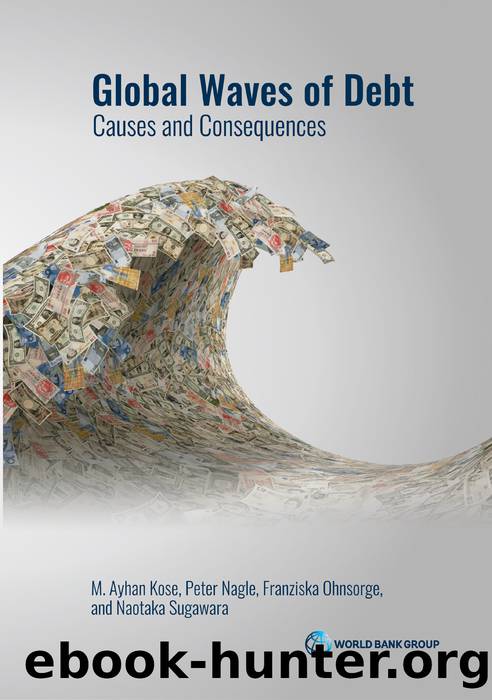Global Waves of Debt by M. Ayhan Kose Peter Nagle Franziska Ohnsorge & Naotaka Sugawara

Author:M. Ayhan Kose, Peter Nagle, Franziska Ohnsorge & Naotaka Sugawara
Language: eng
Format: epub
Source: World Bank.
Note: Data are per capita GDP level (at 2010 prices and exchange rates) in each region at the precrisis peak and the end of the wave in each region, indexed to the start of the wave. For LAC and SSA in the first wave, the peak was in 1980; in EAP and ECA in the second wave it was in 1997; and in ECA in the third wave it was in 2008. The orange diamonds in panels A-D show the average for all EMDEs excluding the highlighted regions in each chart, for the corresponding years. EAP = East Asia and Pacific; ECA = Europe and Central Asia; EMDEs = emerging market and developing economies; LAC = Latin America and the Caribbean; SSA = Sub-Saharan Africa.
â¢Output cost. In the first wave, LAC suffered a lost decade of no per capita income growth following the 1982 crisis. Per capita income levels in LICs in SSA fared even worse, with GDP per capita declining for many years. Sovereign debt crises in Russia and Turkey during the second wave also generated severe output losses. In contrast, in the second wave, EAP countries with predominantly private debt buildups experienced only short-lived slowdowns in the wake of the Asian crisis. In the third wave, ECA countries with largely private debt buildups saw large but short-lived declines in output. In contrast to those economies in the ECA region, most EMDEs weathered the global financial crisis relatively well (Kose and Ohnsorge 2020). They used the ample policy buffers that they had accumulated before the crisis and put their reformed frameworks of monetary, fiscal, and financial policies to good use (Koh and Yu 2020).
â¢Currency depreciations. Depreciations were substantially larger and more common in the first and second waves, when exchange rates had been mostly fixed or attached to crawling pegs and often had to be abandoned in the face of speculative attacks (Bolivia, Brazil, and Mexico in the first wave; Argentina, Indonesia, Russia, and Thailand in the second wave). By the third wave, more countries had flexible exchange rates, reducing the likelihood of currencies becoming substantially overvalued to begin with.
â¢Inflation. Increases in inflation following crises were greatest in the first wave, although they were also substantial in some cases in the second (Indonesia). Inflation outcomes have generally reflected the magnitude of currency depreciations. The smaller rise in inflation in the third wave also reflected improved monetary policy frameworksâthe move toward inflation-targeting and independent central banks, which helped anchor inflation expectations (Ha, Kose, and Ohnsorge 2019).
Download
This site does not store any files on its server. We only index and link to content provided by other sites. Please contact the content providers to delete copyright contents if any and email us, we'll remove relevant links or contents immediately.
International Integration of the Brazilian Economy by Elias C. Grivoyannis(91022)
The Radium Girls by Kate Moore(11921)
Turbulence by E. J. Noyes(7936)
Nudge - Improving Decisions about Health, Wealth, and Happiness by Thaler Sunstein(7615)
The Black Swan by Nassim Nicholas Taleb(7010)
Rich Dad Poor Dad by Robert T. Kiyosaki(6401)
Pioneering Portfolio Management by David F. Swensen(6226)
Man-made Catastrophes and Risk Information Concealment by Dmitry Chernov & Didier Sornette(5921)
Zero to One by Peter Thiel(5686)
Secrecy World by Jake Bernstein(4646)
Millionaire: The Philanderer, Gambler, and Duelist Who Invented Modern Finance by Janet Gleeson(4376)
The Age of Surveillance Capitalism by Shoshana Zuboff(4209)
Skin in the Game by Nassim Nicholas Taleb(4162)
Bullshit Jobs by David Graeber(4094)
The Money Culture by Michael Lewis(4076)
Skin in the Game: Hidden Asymmetries in Daily Life by Nassim Nicholas Taleb(3929)
The Dhandho Investor by Mohnish Pabrai(3699)
The Wisdom of Finance by Mihir Desai(3653)
Blockchain Basics by Daniel Drescher(3507)
